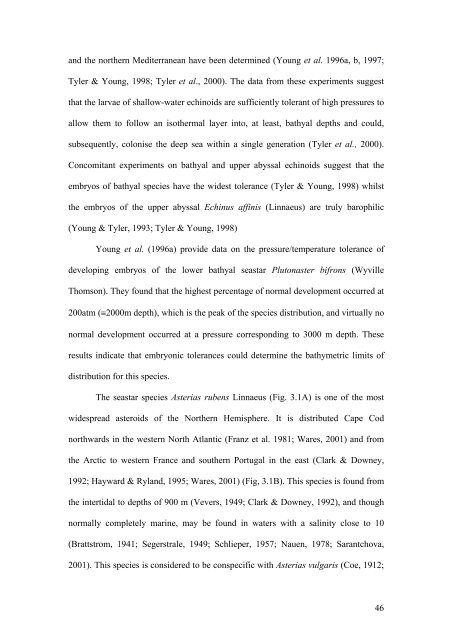Download (3398Kb) - ePrints Soton - University of Southampton
Download (3398Kb) - ePrints Soton - University of Southampton
Download (3398Kb) - ePrints Soton - University of Southampton
Create successful ePaper yourself
Turn your PDF publications into a flip-book with our unique Google optimized e-Paper software.
and the northern Mediterranean have been determined (Young et al. 1996a, b, 1997;<br />
Tyler & Young, 1998; Tyler et al., 2000). The data from these experiments suggest<br />
that the larvae <strong>of</strong> shallow-water echinoids are sufficiently tolerant <strong>of</strong> high pressures to<br />
allow them to follow an isothermal layer into, at least, bathyal depths and could,<br />
subsequently, colonise the deep sea within a single generation (Tyler et al., 2000).<br />
Concomitant experiments on bathyal and upper abyssal echinoids suggest that the<br />
embryos <strong>of</strong> bathyal species have the widest tolerance (Tyler & Young, 1998) whilst<br />
the embryos <strong>of</strong> the upper abyssal Echinus affinis (Linnaeus) are truly barophilic<br />
(Young & Tyler, 1993; Tyler & Young, 1998)<br />
Young et al. (1996a) provide data on the pressure/temperature tolerance <strong>of</strong><br />
developing embryos <strong>of</strong> the lower bathyal seastar Plutonaster bifrons (Wyville<br />
Thomson). They found that the highest percentage <strong>of</strong> normal development occurred at<br />
200atm (≡2000m depth), which is the peak <strong>of</strong> the species distribution, and virtually no<br />
normal development occurred at a pressure corresponding to 3000 m depth. These<br />
results indicate that embryonic tolerances could determine the bathymetric limits <strong>of</strong><br />
distribution for this species.<br />
The seastar species Asterias rubens Linnaeus (Fig. 3.1A) is one <strong>of</strong> the most<br />
widespread asteroids <strong>of</strong> the Northern Hemisphere. It is distributed Cape Cod<br />
northwards in the western North Atlantic (Franz et al. 1981; Wares, 2001) and from<br />
the Arctic to western France and southern Portugal in the east (Clark & Downey,<br />
1992; Hayward & Ryland, 1995; Wares, 2001) (Fig, 3.1B). This species is found from<br />
the intertidal to depths <strong>of</strong> 900 m (Vevers, 1949; Clark & Downey, 1992), and though<br />
normally completely marine, may be found in waters with a salinity close to 10<br />
(Brattstrom, 1941; Segerstrale, 1949; Schlieper, 1957; Nauen, 1978; Sarantchova,<br />
2001). This species is considered to be conspecific with Asterias vulgaris (Coe, 1912;<br />
46
















